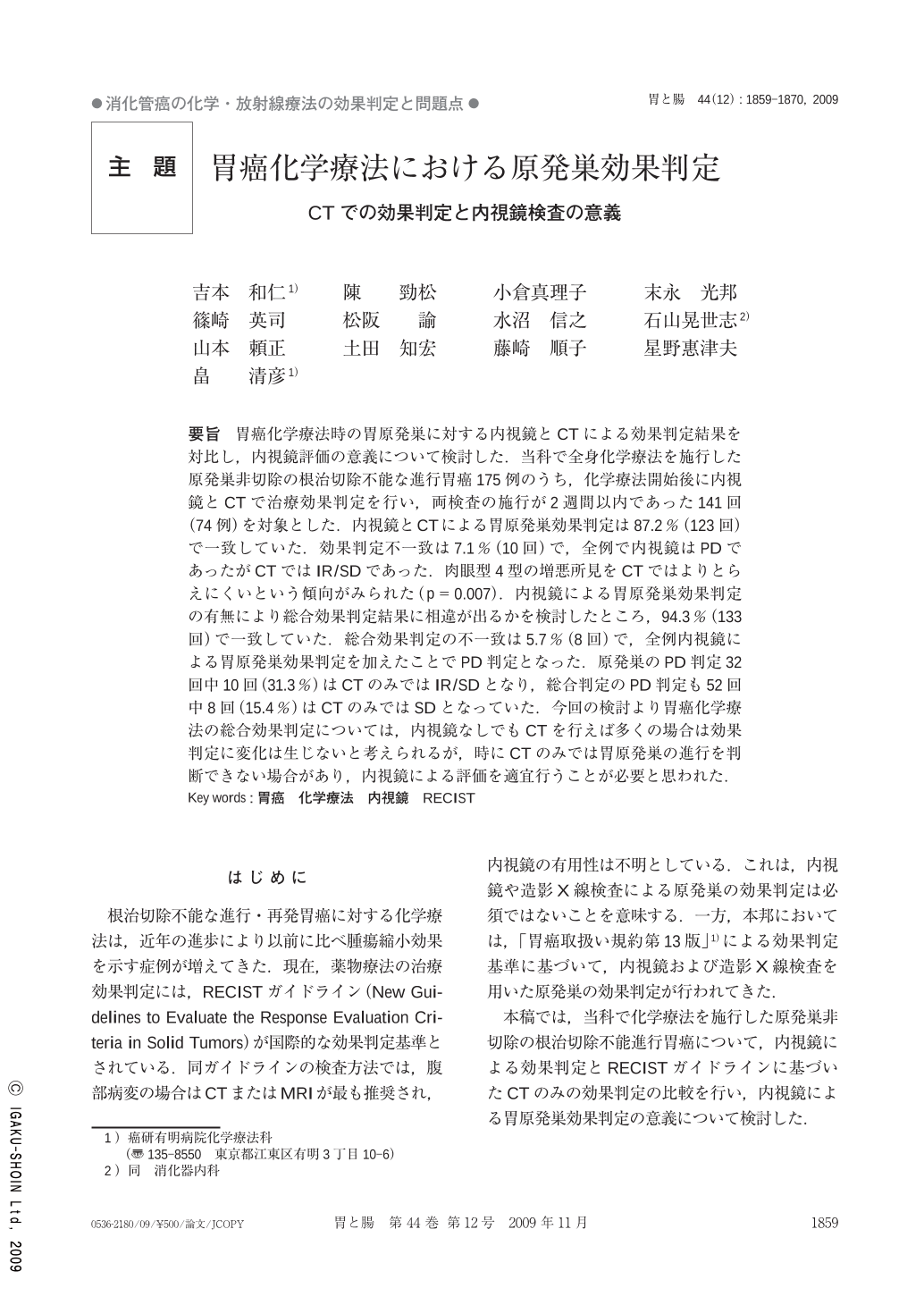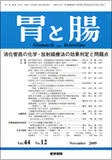Japanese
English
- 有料閲覧
- Abstract 文献概要
- 1ページ目 Look Inside
- 参考文献 Reference
要旨 胃癌化学療法時の胃原発巣に対する内視鏡とCTによる効果判定結果を対比し,内視鏡評価の意義について検討した.当科で全身化学療法を施行した原発巣非切除の根治切除不能な進行胃癌175例のうち,化学療法開始後に内視鏡とCTで治療効果判定を行い,両検査の施行が2週間以内であった141回(74例)を対象とした.内視鏡とCTによる胃原発巣効果判定は87.2%(123回)で一致していた.効果判定不一致は7.1%(10回)で,全例で内視鏡はPDであったがCTではIR/SDであった.肉眼型4型の増悪所見をCTではよりとらえにくいという傾向がみられた(p=0.007).内視鏡による胃原発巣効果判定の有無により総合効果判定結果に相違が出るかを検討したところ,94.3%(133回)で一致していた.総合効果判定の不一致は5.7%(8回)で,全例内視鏡による胃原発巣効果判定を加えたことでPD判定となった.原発巣のPD判定32回中10回(31.3%)はCTのみではIR/SDとなり,総合判定のPD判定も52回中8回(15.4%)はCTのみではSDとなっていた.今回の検討より胃癌化学療法の総合効果判定については,内視鏡なしでもCTを行えば多くの場合は効果判定に変化は生じないと考えられるが,時にCTのみでは胃原発巣の進行を判断できない場合があり,内視鏡による評価を適宜行うことが必要と思われた.
Significance of endoscopic evaluation in the assessment of response to chemotherapy for primary gastric cancer was measured by comparing it with the response assessment using computed tomography(CT). In the Division of Medical Oncology, Cancer Institute Hospital, Japan, there were 175 cases in which chemotherapy was administered for unresectable advanced gastric cancer and then response assessment was carried out using endoscopy and CT. Of the 175 cases, we reviewed 74(141 assessments)cases in which the two tests were completed within 2 weeks. In 87.2%(123 assessments)of the cases, the response evaluation of the primary lesion using endoscopy was identical to that using CT. However, discrepancies in the assessments were seen in 7.1%(10 assessments)of the cases. In all of those cases, the lesions were assessed as PD by endoscopy, whereas by CT, the evaluation of IR/SD was made. Progression of Borrmann type 4 lesions was more difficult to detect with CT than with endoscopy(p=0.007). Regarding the influence of endoscopic evaluation of primary lesions on the overall response assessment, in 94.3%(133 assessments)of the cases, the assessment using endoscopy was identical to the overall assessment. However, in 5.7%(8 assessments)of the cases, disagreement between the assessments was seen, and all cases required evaluation by endoscopy to reach the conclusion that the lesions were PD. The primary lesions were assessed as PD 32 times, while in 10 attempts(31.3%), the lesions would have been evaluated as IR/SD with CT alone. Likewise, in 52 attempts in which the overall assessment of PD was confirmed, without endoscopy, 8 attempts(15.4%)would have been evaluated as SD. We concluded that CT alone is almost sufficient for the overall response assessment of chemotherapy for gastric cancer, although there are some cases in which the progression of the primary lesion cannot be identified with CT alone. In those cases, endoscopic evaluation is essential for accurate response assessment.

Copyright © 2009, Igaku-Shoin Ltd. All rights reserved.


